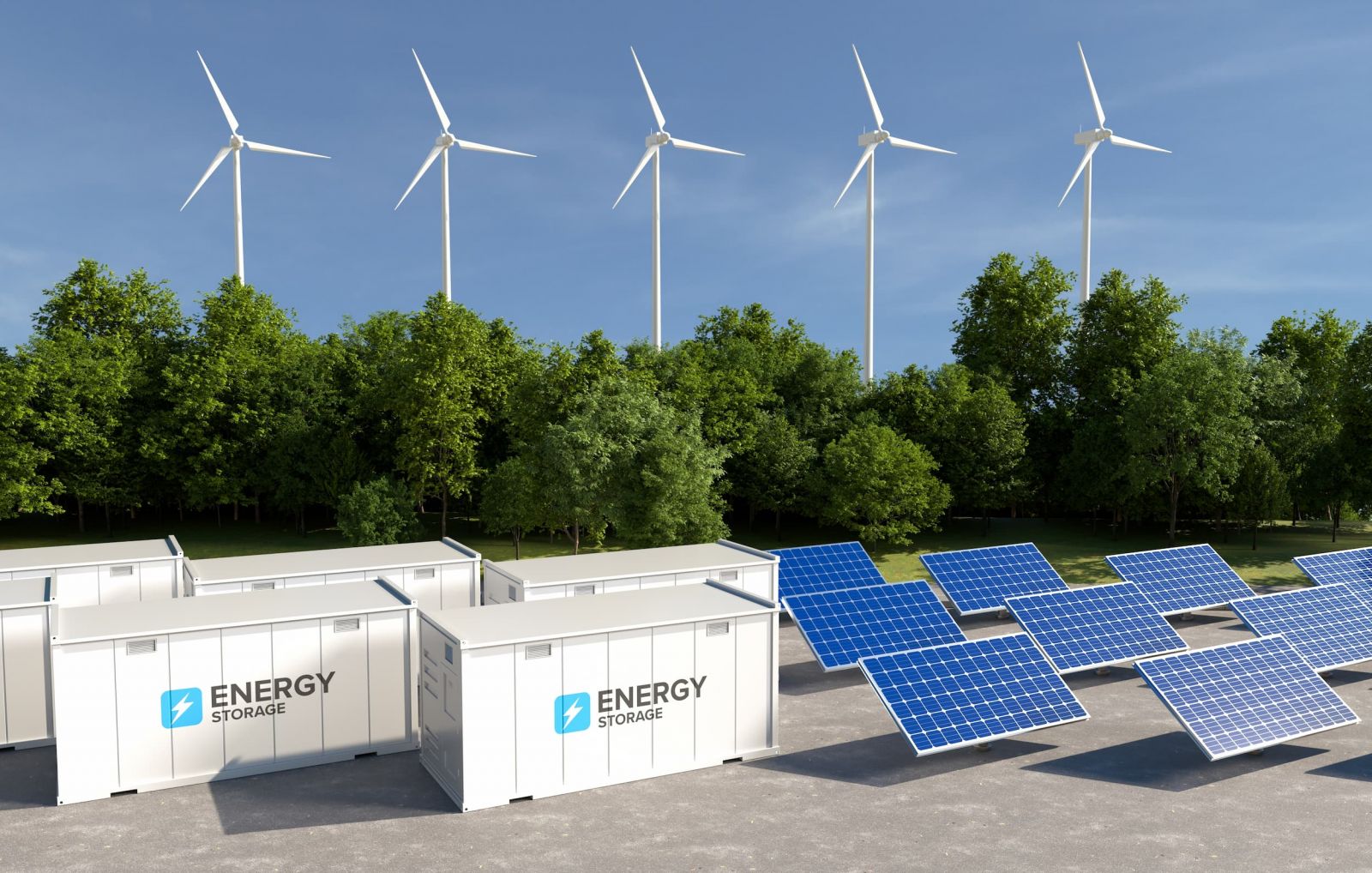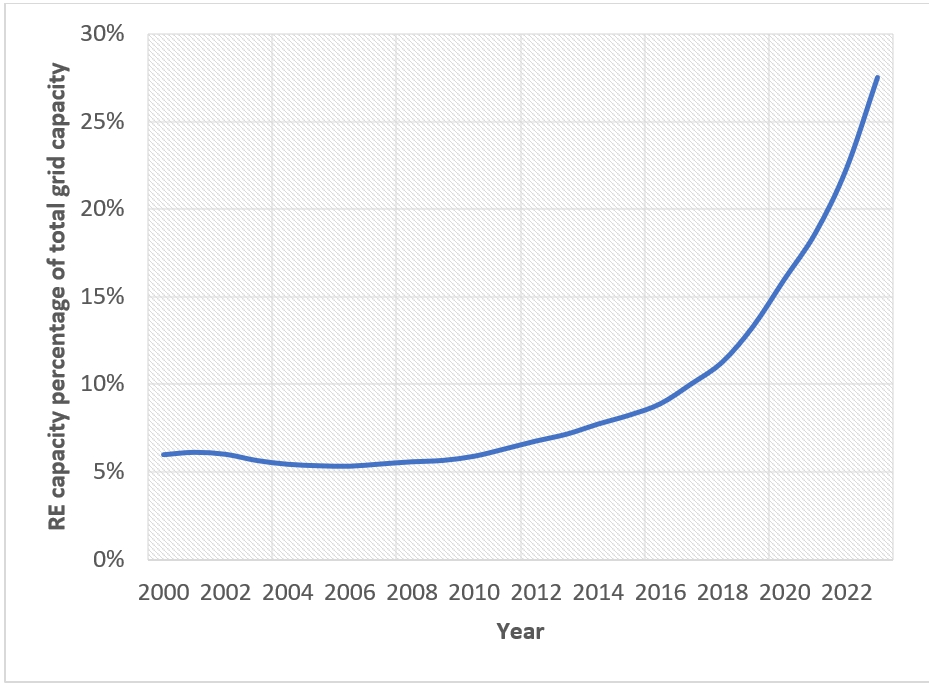Sustainability & CSR
The crucial role of energy storage
Energy storage systems are an essential element in Taiwan’s energy transition
By Bart Linssen

The challenge
The renewable energy capacity in Taiwan’s electricity grid has increased exponentially over the past few years. This article aims to explain in simple terms what this means for the electricity grid and what measures need to be taken to maintain grid stability.
The figure below shows the growth in renewables over the past 10 years.

Installed renewable energy capacity in Taiwan as a percentage of total grid capacity
Keep in mind that the picture above shows installed capacity. The renewable energy produced as part of total energy generated is less than 20%. As the "behaviour" of renewable energy sources, in particular solar and wind, are different from those of traditional electricity generation sources, this increased renewable energy content in the grid has significant effects on how the electricity grid operates. The technology to maintain grid stability is available and there have been significant investments in these technologies in Taiwan.
Electricity grid basics
In order to understand the challenges of an increase in renewable energy generation in the grid, we need a basic understanding of how the grid works. When we speak about the electrical grid we talk about all equipment interconnected to provide electrical power to consumers. The electrical grid includes the electricity generation equipment, either powered by fossil fuels or renewable, all cabling and auxiliary equipment to enable the transmission of electricity to end consumers and all kinds of electrical loads, from your home's washing machine, to electrical industrial production machinery.
Due to technical and historical reasons that are beyond the scope of this article, the grid in Taiwan runs on a frequency of 60Hz. This frequency is important. The frequency may fluctuate a bit but may not deviate too much because all equipment, both on the production side as well as on the consumption side, is designed to operate on this frequency. If the frequency deviates too much, the equipment (on both the production and consumption side) will malfunction or the equipment’s surge protection devices may take the equipment off the grid.
Frequency changes occur when electricity supply and demand are mismatched. If supply exceeds demand, frequency will increase, and if demand exceeds supply, the frequency will decrease. Due to the "inertia" of the grid, changes in frequency due to this mismatch between power supply and demand occur slowly, allowing the utility to react by adjusting power supply. If you are more mechanically inclined you can compare this to an immense flywheel with motors on one side driving the flywheel and motors on the other side being driven by the flywheel. If supply and demand are mismatched, the flywheel will either increase in speed or slow down.
A worst-case scenario is where frequency changes so much that it causes switches around the grid that protect equipment against large fluctuations to be activated. This can create a cascade effect where multiple clusters of load or production equipment are taken off the grid. This happened on 3 March 2022, during the grid outage caused by an equipment malfunction at the Hsinta power plant.
Capacity mismatches are traditionally covered by spare generation capacity, either by spinning reserve (increasing or decreasing the output power of equipment already in operation) or starting up additional capacity. Depending on the type of generation (coal, nuclear, gas) the response time of starting additional capacity can take minutes to hours. So, switching off a load on the load side of the grid, will lead to a decrease in production on the production side and vice versa.
What renewables do to grid stability
Some renewables are intermittent. If the wind doesn't blow or the sun doesn't shine, no power is produced. Therefore renewables like wind and solar are not always available to supply power to the grid and cannot always be relied upon by the utility to stabilize the frequency of the grid.
A second effect of renewables is that much of the renewable electricity is fed into the grid through so-called inverters. Inverters can deliver different voltages and frequencies by using semiconductor technology. Inverters lack the "inertia" described previously, so mismatches between load and supply may lead to faster fluctuations in frequency. The more inverter power production in the grid, the less the inertia of the grid, reducing the capability of the grid to withstand sudden load variations. Interestingly, these same inverters also provide the solution to this problem.
How to keep the grid stable
A larger share of renewables in the production of electricity means less reserve capacity is immediately available to maintain the grid frequency and less "inertia" of the grid, i.e., grid frequency may be more prone to faster fluctuations. In order to maintain grid stability, either some form of extra other production capacity needs to be brought online on very short notice, or load has to be shed.
Shedding load: Shedding load can be done by demand response, a type of load shedding where an end user’s electricity use (load) is reduced during periods of high power prices or when the reliability of the grid is threatened under a voluntary programme where these customers receive payments for this curtailment.
Increasing energy generation: On the supply side there are several options to maintain grid stability. The traditional method is an operating response by spinning reserve. You adjust the “gas throttle” of your fossil fuel power plant to adapt to the changes in load and maintain a stable frequency. This is a viable option in the current grid where the ratio of renewables is still relatively low. However, with increased renewables, the option to decrease and increase power supply in such a way becomes increasingly less feasible.
This is where Energy Storage Systems (ESS) come in. ESS comes in many shapes and forms. Commonly seen solutions are pumped hydro and battery storage. Taipower has a pumped hydro station at Sun Moon Lake, called the Mingtan dam, with a capacity of 1.6GW, where water is pumped upstream during times of excess electricity production and released in times of peak consumption.
The other increasingly common solution is Battery Energy Storage Systems (BESS), and here is where the biggest growth will happen in the coming years. BESSs are versatile in the services they can deliver to the grid, from fast response to long term power supply.
Some of the most common applications of Battery Energy Storage Systems are:
Arbitrage: Store energy when energy prices are low and return power to the grid when power prices are high.
Peaking capacity: Provide reliable capacity to meet peak demands in return for a fee.
Operating reserve and ancillary services: This includes very fast response to variations in demand and generation,
Transmission upgrade deferrals: By evening out the transmission of energy over a transmission line, i.e., by “shaving off” the peaks in energy transmission, adding battery storage can be an alternative to upgrading the capacity of a transmission line.
Black start: Provide the energy to bring generation units back online after a system wide failure.
Taiwan’s battery storage market
Battery Energy Storage Systems are in use both at Taiwan’s monopoly utility Taipower, as well as by private entities. To enable the investment in BESS from the private sector, Taipower has set up an energy trading platform (etp.taipower.com.tw). This has attracted a lot of attention from investors; the number of applications exceeded the needed capacity by eight times in 2023, resulting in Taipower having to temporarily stop the filing of new applications.
Another application for battery storage is for individual electricity off-takers. For those companies aiming to achieve 24/7 renewables for example, on-site battery storage is an important piece of that puzzle. Battery storage may also be used to shift away utility electricity use from expensive hours to cheaper off-peak hours.
According to the Taiwan Energy Agency, the target for battery storage in Taiwan is 1.5GW by 2025 and 5.5GW by 2030. If we include on-site applications for battery storage, Taiwan is expected to reach 2GW / 5GWh by 2025 and 9GW / 24GWh by 2030, representing a US$2.7 billion market.
Bart Linssen, RCI Engineering